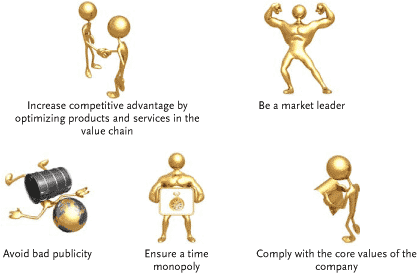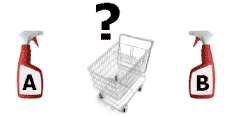|
Development of cleaner products in Berendsen's international product chains 2 Introduction and MotivationSophus Berendsen A/S has been one of the pioneer companies in Denmark concerning product/service orientation of environmental work. In 2002 Sophus Berendsen A/S was acquired by the Davis Service Group plc. and most of the corporate functions, including the environmental department, were closed down and responsibility transferred to the national subsidiary companies. For the Danish subsidiary company - Berendsen Textile Service A/S – the changes meant that they could no longer get support for environmental work from the parent company. Today environmental work is an integrated part of the different departments of Berendsen Textile Service A/S. Environmental product development projects are anchored in the sales and marketing division of the company. 2.1 Motivation for environmental product developmentThere are different reasons for Berendsen and their suppliers to be active in product development.
Figure 6. Berendsen has many different motivations to participate in development of cleaner products 2.1.1 Cooperation on optimizing the value chainOne important driver to work with development of cleaner products in product chains relates to the concept of value chain thinking.
Figure 7. There are many considerations when choosing between product A and product B. When you are choosing between two products in the supermarket, there are a lot of important parameters like the price and quality that you probably use. For a company selecting a supplier or a product the situation is quite similar. Some typical competitive parameters in business-to-business relations are:
All these parameters are influenced through the value chain. An example is that if your supplier is not able to deliver the components that you use to produce your product within a certain time, then you cannot produce and deliver your products to the customers in time. Hence, competition on a market is a competition between two or more value chains and not only two or more companies. Therefore, all companies in a value chain share the same interest - to optimize the whole value chain to be competitive. This gives an incentive for the supply chain of a company to adapt to the requirements of the final consumer.
Figure 8. Cooperation in the value chain to improve the competitive parameters for the final product/service yields better competitiveness. This is a motivation to cooperate on optimizing the value chain as a whole. 2.1.2 Be market leaderBerendsen Textile Service A/S is the biggest textile service company in Denmark, with 19 service centres and about 1,500 employees. At Berendsen they see themselves as the market leader, which means that they want to stay ahead of the competitors and the legislation. In relation to development of cleaner products, Berendsen does not want to let the legislation set their product standard, but wants to meet the present and future needs and requirements of their customers. 2.1.3 Avoid bad reputationToday the tendency is that, as a company, you are held responsible for the actions of your suppliers. The pressure is high if you have a well-known brand and are located in the value chain close to the end consumer. A good example of this is Nike. In 1996 in the CBS TV programme 48 hours, the very poor working conditions for workers at some Asian Nike suppliers were revealed. Nike got all the blame and bad reputation and based on this the company implemented a code of conduct to be met by all suppliers. Today Nike has become more open and in 1995 they revealed information about their supplier factories. Berendsen, of course, is not as strong a brand as Nike, but still the brand is well-known on most of the markets where they are present*.
Figure 9. Berendsen logo since 1998 - a modern simplification of the original bear logo for Sophus Berendsen A/S founded in 1854. In Denmark there is a lot of focus in the media on consumer protection, and consumer organizations test different products to reveal problems. Often you read about problems with allergies from cosmetics. During the project, headlines such as “keep your hands off the soap” and “liquid soap causes allergy” have been present in the media. The press coverage was a result of a survey from the Danish Information Centre for Environment & Health showing that the majority of all liquid soaps on the market contain the allergen preservative MG (methyldibromo glutaronitrile). As Berendsen had already phased this preservative out of their soap products, they managed to use the negative publicity about soap products in a positive way. Hence, they could tell their clients that their soap products were safe and did not contain MG. As a large service company, Berendsen has a lot of suppliers – and unfortunately it is not possible to work closely together with all of them in developing new sustainable products. However, it is important for Berendsen to make sure that the suppliers act in compliance with the “code of conduct” of Berendsen. As a part of this Berendsen uses the internet-based tool Supplier-evaluation from FORCE Technology to evaluate and follow up on the performance of their suppliers. 2.1.4 Time monopolyProduct innovation is a way of staying ahead of competitors – also when the innovation is related to cleaner products. A certain segment of the market will require environmentally friendly and healthy products. Hence, if you at a certain time are the only one able to deliver, then until the competitors are able to deliver the same type of products you have a time monopoly for this segment of the market. 2.1.5 Comply with core valuesThe motivation of Berendsen is also more or less covered by the six core values on which the company builds.
Fodnoter * Berendsen Textile Service A/S shares brand with other companies in the Sophus Berendsen A/S group owned by Davis Service Group plc. Sophus Berendsen A/S operates with the Berendsen brand in Denmark, Sweden, Norway, Germany, the Netherlands, Poland and Estonia.
|


